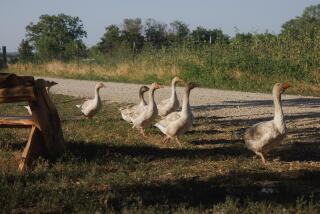Alternative Agricultural Techniques Are Yielding a Bounty of Benefits : Farming: Advocates say the methods promote organic foods, improve environment and cut production costs.
- Share via
WASHINGTON — The new use of old farming practices is enjoying immense popularity as “alternative” agricultural methods edge further into the limelight.
Don’t forget the boll weevil when these newfangled farming methods are brought up. That legendary cotton pest might be an example of how the good guys can win if old habits are broken and new methods adopted.
But first, a little background.
Called by a number of names--low-input sustainable agriculture, or LISA, is one--the concept of alternative agriculture is attractive to many farmers because it involves cutting production costs. And that can produce larger profits.
By whatever name, advocates have been urging alternative agriculture for years, some wanting to promote the cause of organic foods, others seeking to improve the environment, still others who believe farm production costs are far too high.
Advocates got a big lift from the National Research Council in its Sept. 7 “Alternative Agriculture” report.
One major recommendation was that federal farm programs should be changed to encourage the use of fewer chemicals and to help farmers get back to the old system of crop rotations and other sound conservation practices.
“Well-managed alternative farming systems nearly always use less synthetic chemical pesticides, fertilizers and antibiotics per unit of production than comparable conventional farms,” the report said.
“Reduced use of these inputs lowers production costs and lessens agriculture’s potential for adverse environmental and health effects without necessarily decreasing--and in some cases increasing--per-acre crop yields and the productivity of livestock management systems.”
Now, about the boll weevil’s contribution to the environment and agricultural profitability.
The boll weevil for generations of cotton farmers has been one of the dire threats to livelihood. By the late 1920s, the weevil had spread to the entire Cotton Belt, from the Atlantic to Brownsville, Tex.
According to USDA historians, the entire economy of the South was affected. Farmers, bankers and merchants suffered. Many went broke, farms were abandoned and tenants moved away.
The era of DDT and its chemical relatives raised hopes against the boll weevil and other insect pests. But by 1955 the weevil joined other insects that had developed resistance to the chlorinated hydrocarbons such as DDT.
Gradually, many of the powerful chemicals were banned or phased out in favor of more effective versions. All were increasingly expensive to use.
In 1978, a small-scale cotton boll-weevil eradication program began in parts of North and South Carolina. It was gradually expanded into all of the two states and eventually into others, including Virginia, Georgia, Florida and Alabama.
The department’s Economic Research Service recently published a study on the economic returns from the boll-weevil eradication project in North and South Carolina from 1978 through 1987.
“The eradication program yielded an annual rate of return of 187% for farmers; 97% when all public costs are included,” the report said. “Fewer applications of pesticides following eradication also benefit the environment.”
Basically, the cooperative program involved close attention to insect cycles, tillage methods and timing, targeting chemical applications properly and the use of many other factors relating to the pests and local conditions.
“The economic benefit from the eradication program flows primarily from a 69-pound gain in per-acre cotton yields and an annual cost savings of about $30 per acre from using less pesticides,” the report said. “Cotton land gained $14 per acre in value as farmers switched from less profitable crops.”
Researchers admitted that the weevil eradication program benefited from the colder weather of the Carolinas and that the procedures “may be less effective in warmer areas such as Georgia and Alabama.”
Further, the report cautioned: “The high rate of return and the biological success of the eradication program from the Carolinas can be extended to other regions only with extreme caution.”
Even within the two states, there were large differences. For example, pesticide savings were only $6.74 per acre in the North Carolina piedmont, but were $24.97 per acre in the South Carolina piedmont.
Although the weevil study did not address the broader issue of alternative agriculture, it did highlight a few of the benefits suggested in the National Research Council’s report.
In its call for more research money, the council’s report said the priorities for an expanded program for competitive research grants should include an analysis of pest-control needs.
Development of new pest-management strategies should be sought to “take advantage of cultural practices” available to farmers, crop rotations and the use of beneficial insects, parasites and diseases to control pests, it said. Other biological and genetic pest controls should also be developed.
In a way, then, the long war against the boll weevil may be a model for other efforts. At least it worked in the Carolinas, the Agriculture Department says.
More to Read
Sign up for Essential California
The most important California stories and recommendations in your inbox every morning.
You may occasionally receive promotional content from the Los Angeles Times.













